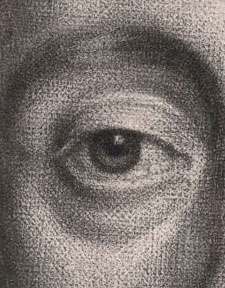- Relief printing
- Intaglio and planographic printing
- Color printing
- Bits and pieces
- Early photography in silver
- Non-silver processes
- Modern photography
- Color notes
- Color photography
- Photography in ink: relief and intaglio printing
- Photography in ink: planographic printing
- Digital processes
- Where do we go from here?
What is the reason for doing mezzotint for commercial purposes?

Mezzotint. After Sir Anthony Van Dyck. King Charles I. c. 1635 (Printed by Isaac Beckett, c. 1685). 13 1/8 x 9 13/16" (33.3 x 25 cm). Collection of John Benson. Beckett’s title, beautifully engraved on the mezzotint plate, is “Charles, by the grace of God King of England, Scotland, France and Ireland.”
The mezzotint is a strange intaglio process that was developed in the early 1600s. The basis of the process was to cover a plate with ink-holding surface indentations such that it would print a deep, even, black tone, then to polish out some of those serrations to make them print lighter. This variation of light and dark produced the picture. The nickname for mezzotint was “manière noire,” reflecting the fact that the picture was extracted from blackness. The initial plate preparation was done by someone in the printshop—certainly not the artist—and was carried out by roughening the plate surface with a tool called a “rocker,” a chisellike instrument with a curved cutting edge and with grooves running along the length of the blade.

Detail of Mezzotint. After Sir Anthony Van Dyck. King Charles I. c. 1635 (Printed by Isaac Beckett, c. 1685). 13 1/8 x 9 13/16" (33.3 x 25 cm). Collection of John Benson. This four-times enlargement shows the somewhat mechanical marks of the rocker. The burnishing that makes the picture does not create new marks but simply lightens those already on the surface. Much effort went into rocking the plate in such a way that the marks left as little pattern as possible.
When this tool was rocked firmly back and forth on the plate, and gradually moved across it, the plate took on a mixture of indentations and raised burrs across its entire surface. If inked, a plate thus prepared would have printed a smooth black tone. First, though, the artist worked on it with a burnisher, a small handheld tool with a rounded, highly smooth tip. The polished areas of the surface held less ink than the rougher ones and produced the lighter tones of the picture. The process is considered intaglio—printing from the low—but as well as sinking grooves, the rocker raised burrs that probably held just as much ink, making the technique in many ways related to drypoint.
However we classify it, mezzotint produced beautiful values and a fundamentally different look from any other kind of print, but the plate was extremely delicate and had to be printed with great care. Mezzotint editions were far smaller than those of engravings or etchings because of this fragility of the plate. It is very hard to make a good picture with an eraser, which is what the artist was doing in burnishing the plate. In many mezzotints, then, the technique dominates the image and the pictures suffer accordingly. The beautiful and eccentric picture of King Charles of England shows the tonality that mezzotint made possible, but also its potential weaknesses: uneven areas of large tone when no detail is present, and a somewhat odd appearance in the lighter values, which comes from the difficulty of knowing just how the burnished plate will carry ink. When mezzotints were just right, though, their beauty was breathtaking and their degree of technical refinement astonishing.

